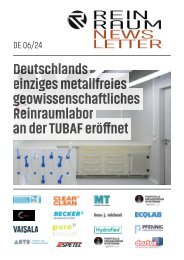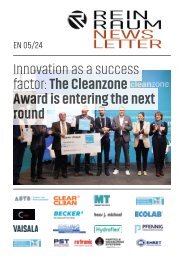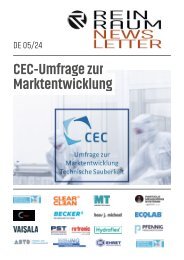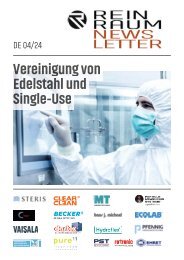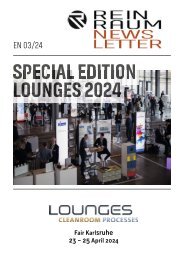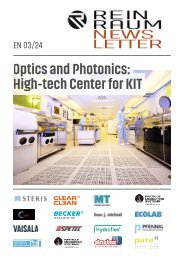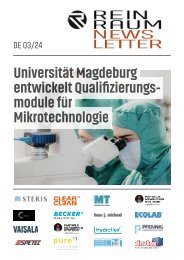Newsletter_04-2024_EN
Create successful ePaper yourself
Turn your PDF publications into a flip-book with our unique Google optimized e-Paper software.
In particular, products with unusual requirements such as fluids with
high undissolved abrasive components (e.g. calcium carbonate, tricalcium
phosphate) can be tested with the system from LEWA. Even
small quantities of expensive fluids can be tested in „stand-alone“
operation without any problem.
Optimal results from the interplay between pump and valve
The heart of the system is the proven LEWA triplex high-pressure
process diaphragm pump. It ensures that the process fluid flows
through the integrated two-stage homogenization valve at the required
flow rate and pressure. It is dynamically controlled and is de-
The flow rate and pressure required to homogenize the process fluid at
the two-stage, dynamically controllable homogenization valve are realized
by a LEWA triplex process diaphragm pump. (Source: LEWA)
signed for a maximum pressure of 400 bar and a flow rate of up to 150
l/h in the test system. The LEWA triplex piston diaphragm pump also
offers a decisive advantage for homogenization: Due to its design,
the diaphragm pump does not require dynamic sealing systems. The
PTFE sandwich diaphragm – additionally equipped with leakage detectors
– ensures a hermetically sealed working chamber, such that
no emission or leakage of substrate or cleaning media or contamination
of the fluid can occur. In addition to this function, which enables
aseptic process control, all media-relevant components are designed
in accordance with the applicable hygiene specifications, e.g.,
the „Hygienic design of pumps, homogenizers and steaming equipment“
EHEDG guidelines, and are easy to clean inline (CIP, SIP) –
but also easily accessible for inspection and maintenance purposes.
„The actual homogenization process benefits from the close
interplay between customer-specific conveyor units and system
components,“ explained Dr. Johl. First, a hygienic twin screw pump
generates a specified inlet or suction pressure on the suction side
of the high-pressure pump, which is particularly important for higher
viscosities. Next, the speed-controlled high-pressure diaphragm
pump conveys the fluid at the required flow rate to a preselected
pressure P2 in the second stage. The valve remains pneumatically
closed according to the selected pressure. As soon as the pressure
and pump capacity are reached, the homogenization valve of the
first stage closes to the extent that the specified value also applies
there. The valve of the second stage is now no longer controlled. „The
ratio between the pressures is usually P2 < 1/5 x P1, but it can also
be freely selected. The homogenization pressure of the first stage,
which is now leading, is maintained by pneumatic valve control of
the dispersion gap. In this way, the homogenization process remains
virtually free from pressure fluctuations. The choice of type and design
of the homogenization valves can be specified by the customer
for later scaling of production systems. Due to sufficiently selectable
pressure reserves, a later system can also directly supply a downstream
spray drying step, which further increases the efficiency and
flexibility of the process.
Compact design and flexible control for versatile use
All system components are selected according to hygiene requirements
and mounted on a common base frame, making the system particularly
suitable for pilot or small batch processes thanks to its compact and
space-saving design. (Source: LEWA)
The system can be operated both in a circuit and continuously in the
customer process. Fluid is supplied either via the heatable vessel or a
separate media connection. (Source: LEWA)
All components are designed for hygiene and are mounted on a
common base frame with a „wash-down housing“ for the pump drive.
This compact design enables the system to be installed such that
it saves space in the production environment. Depending on whether
it is operated in a circuit or continuously, the fluid is supplied via
either the integrated heatable double-walled tank with a capacity of
60 l or a separate media connection. In addition, the LEWA smart
control control system is integrated into a control cabinet mounted
on the metering frame: also in hygienic design. Various modes and
preconfigured operating sequences (cleaning, homogenizing, etc.)
are pre-installed for simple and flexible operation. „The safety of the
system is rounded off by various protective measures: a safety valve
that can be automatically vented for cleaning to protect the system
against overpressure on the low-pressure side, a pump-integrated
pressure relief valve on the high-pressure side and various pressure
and temperature transmitters for process monitoring, as well as visual
and acoustic warning elements,“ added Dr. Johl.
From March 19 - 22, 2024, visitors to Anuga FoodTec in Cologne
will have the opportunity to experience the LEWA homogenizer test
system in action. Dr. Hans-Joachim Johl and other LEWA experts
look forward to answering questions and having interesting discussions
at booth D085 in hall 4.1.
LEWA GmbH
D 71229 Leonberg
www.reinraum.de | www.cleanroom-online.com NEWSLETTER | Edition EN 04-2024
page 5/35









